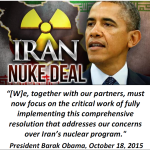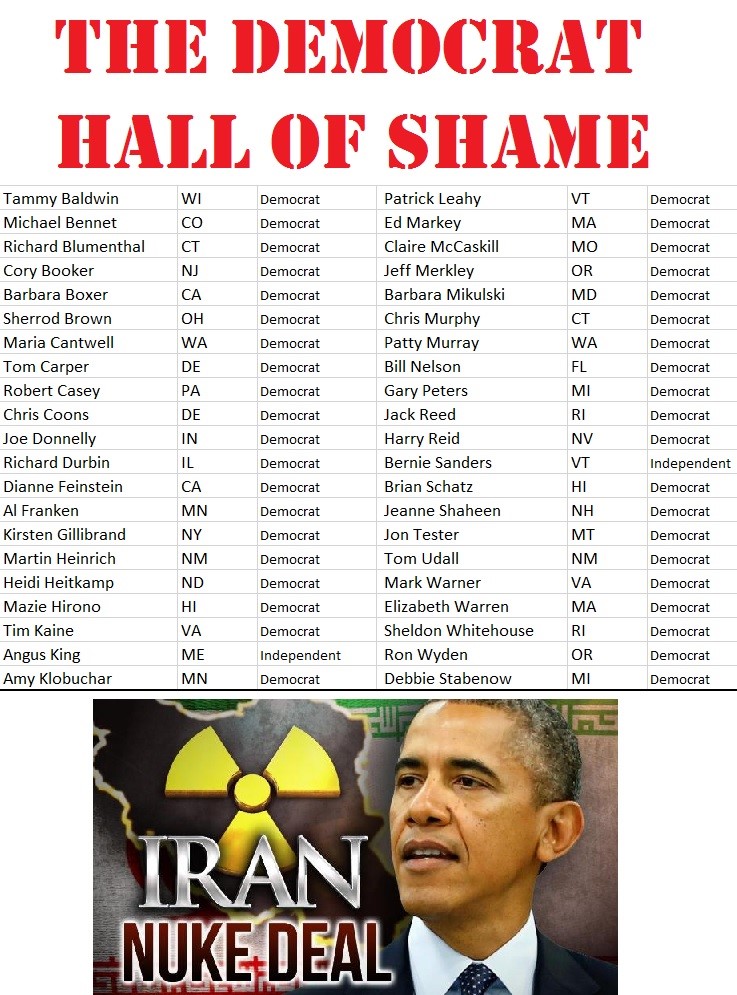“Today marks an important milestone toward preventing Iran from obtaining a nuclear weapon and ensuring its nuclear program is exclusively peaceful going forward. . . . I welcome this important step forward. And we, together with our partners, must now focus on the critical work of fully implementing this comprehensive resolution that addresses our concerns over Iran’s nuclear program.” ~ President Barak Obama, October 18, 2015 . . . We should live so long!
According to the European Council on Foreign Relations’ reading of the Nuclear Deal with Iran, its “Adoption Day” (when the President is supposed to initiate steps to reduce sanctions was yesterday, October 19 — 90 days after the UN Security Council concurred with the Joint Comprehensive Program of Action or JCPOA.) The European Union approved the JCPOA in July. According to Reuters sanctions would not be removed until the International Atomic Energy Agency (IAEA) verifies that Iran has complied with nuclear-related measures. These dates are adapted from Reuters’ timeline for the implementation of the JCPOA as agreed between Iran and six major powers on July 14, 2015. There were no specific dates. It began “upon conclusion of the negotiations”.
- FINALIZATION DAY: * Iran and the major powers “endorse” the plan, known as JCPOA. * The “promptly” submit it to the United Nations Security Council for adoption “without delay”. * The European Union will “promptly” endorse the resulting United Nations Security Council resolution. * Iran and International Atomic Energy Agency (IAEA) will start developing arrangements to implement all transparency measures so that they are ready for Implementation Day.
- ADOPTION DAY: * Takes place 90 days after endorsement by the UN Security Council, or earlier by mutual consent of all the parties. * JCPOA participants will begin making necessary arrangements and preparations for the implementation of commitments. * Iran notifies IAEA that it will apply the Non-Proliferation Treaty’s Additional Protocol (enhanced inspection regime) provisionally with effect from Implementation Day. * Iran starts implementing commitments relating to past nuclear activities. * EU will adopt a regulation lifting nuclear-related sanctions with effect from Implementation Day “simultaneously” with IAEA verification of agreed nuclear-related measures by Iran. * The president of the United States will issue sanctions waivers to take effect on Implementation Day.
- IMPLEMENTATION DAY: * Occurs when IAEA verifies Iran has complied with nuclear-related measures. * The EU suspends or terminates nuclear-related sanctions specified in Annex II of the JCPOA * The United States ceases application of nuclear-related sanctions specified in Annex II. * The United Nations terminates sanctions.
- TRANSITION DAY: * Takes place eight years from Adoption Day, or earlier upon a report from the IAEA director-general stating the IAEA has reached a conclusion that all nuclear material in Iran remains for peaceful activities. * The EU terminates any remaining sanctions. * The United States terminates or modifies remaining sanctions including seeking necessary legislative changes. * Iran will ratify Additional Protocol on enhanced inspections.
- TERMINATION DAY: * Takes place 10 years from Adoption Day provided no U.N. sanctions have been reinstated. * U.N. will pass resolution approving termination of JCPOA. * The UN Security Council “would no longer be seized of the Iran nuclear issue,”or close the file.
On October 18, President Obama reportedly signed the Nuclear Deal with Iran that his administration championed over the objections of the majority of Congress. As of this writing, the top leaders of Iran have not signed on to the Joint Comprehensive Program of Action (JCPOA), though the Iranian Parliament voted its concurrence on October 13, 2015.
Meanwhile, senior Iranian spokesmen have continued to ridicule the Deal while demanding that the sanctions be removed. Remember that the Grand Ayatollah recently declared (after the agreement was completed) that Israel would no longer exist in 25 years, while others chanted in the background, “Death to America!”
Iran also continues its long-standing program to develop ballistic missiles. A little over a week ago, Iran launched a “new generation” nuclear-capable medium-range (about 1000 miles) ballistic missile (MRBM), reportedly with an approximately 1600 pound maneuvering payload to achieve greater accuracy and avoid missile defenses.
U.S. Ambassador to the U.N. Samantha Power noted “deep concern” and issued a statement confirming that “Iran launched on Oct. 10 a medium-range ballistic missile inherently capable of delivering a nuclear weapon . . . a clear violation of U.N. Security Council Resolution 1929.” She told VOA: “So we will indeed bring it to the U.N. Security Council and press for the appropriate action, and we are also looking bilaterally at things we can do as well.”
That Iran continues to violate its U.N. commitments is no surprise — and, in my opinion, U.N. oversight of the JCPOA is likely to achieve no better result. The primary oversight mechanisms are not under U.S. or Israeli control.
Note that Amb. Power’s statement was silent on the Iran Deal, which the White House maintains is completely separate from this incident. The President’s spokesman, Josh Earnest, acknowledged there were “strong indications that those missile tests did violate U.N. Security Council resolutions that pertain to Iran’s ballistic missile activities,” but he maintained with a straight face that “this is altogether separate from the nuclear agreement that Iran reached with the rest of the world.” Click here for a video of his comments, including a claim that they have abided by the terms of the Deal — yet to be executed, even while continuing to violate U.N. conditions.
Andy McCarthy’s scathing criticism of the Obama approach poses a pertinent question, as he concludes, that “The ink hasn’t yet dried and it is already manifest that Obama’s Iran deal is a farce that provides aid and comfort to a committed enemy of the United States. Is Congress planning to do anything about that?”
Here, there should be no surprise, either. Critics, including yours truly, of the JCPOA have argued that one of its many weaknesses is that it does not impose limits on Iran’s development of ballistic missiles, which already pose a threat to attack Israel — and the United States. The administration’s claims are not well received by other critics of the Deal, who are concerned that the battery of Iran sanctions will be lifted prematurely, especially in view of Iran’s overt claims that it will not be bound by its terms.
A bipartisan group of Senate Foreign Relations Committee lawmakers, led by Chairman Bob Corker (R-Tenn.), in a letter, challenged the President to respond to Iran’s violations to U.N. resolutions.
Too bad Senator Corker apparently did not think of this outcome when agreeing to the conditions that did not seek to give the JCPOA the status of a treaty, requiring the advice and consent of two-thirds of the senate — a goal that the administration could not have achieved — and establishing a condition requiring senate approval that could be filibustered by only 41 senators, as achieved by the by the following “Democrat Hall of Shame.” Their names should preserved for posterity:
These issues should surprise no one. As we have pointed out repeatedly, this unverifiable deal is not in the U.S. National interest. See in particular our September 3, 2015 message which heralded a letter signed by 56 former senior policy, technical and military officials, which detailed our concerns to the President and the leaders of both parties of Congress — all to no avail.
In considering these threats, we should not forget the associated jihadi threat that undoubtedly will be further fueled by the relief of sanctions on Iran. SCUD ballistic missiles can be purchased for a few million dollars and the threat of nuclear weapons proliferation might also be advanced by the growing turmoil in the Middle East and East Asia if the Obama foreign policy continues its downward spiral. Not to mention a potential nuclear arms race in that, the most unstable, part of the world.
See Former U.N. Ambassador John Bolton’s summary of how Russia’s increasing prominence in the Middle East (and elsewhere) adds to these concerns. Also, an October 16 Investor’s Business Daily editorial, “Iran Nuclear Deal Gives Free Rein on Missiles and Terrorism,” discusses the coupling of Iran’s extensive underground facilities that add considerably to the JCPOA verification problems as well as enhancing the threat from Iranian development programs, including for nuclear weapons.
And now there are signs that the Obama administration may seek a repeat performance with North Korea. Slow learners, these folks. Will Congress do any better?
Bottom Lines.
We need a changed approach — and “quick fixes” to some very troublesome problems in view of the fact that the Iranian and North Korean ballistic missile threat is clearly going to grow — and our defenses need to be strengthened.
We are vulnerable to threats like the ballistic missile just tested by Iran if it is launched from vessels off our coasts — particularly from the Gulf of Mexico, a threat against which we are currently completely vulnerable. And both North Korea and Iran have launched satellites to their south to approach the United States from over the South Polar regions—again a threat which we need to defend against.
To counter these threats we need to revive Reagan’s “Peace through Strength” vision including effective missile defenses, including those that are space based, and to harden the electric grid against EMP effects.
Near Term High Frontier Plans.
We will continue to inform our readers of the looming threat discussed above — and where appropriate urge them to engage in countering that threat. Our leaders are failing at their sworn duty “to provide for the common defense”
We will press for building the most cost-effective ballistic missile defenses possible and working with South Carolina folks to build a coalition to engage constructively with private citizens and their local and state representatives and other authorities to work with the SC National Guard in understanding and responding to the existential threats to the electric power grid.
We are especially focused on the nuclear power reactors that produce 60 percent of SC electricity — and more generally 20-percent of the nation’s electricity.
If it can be assured that they “operate through” a major blackout of the electric power grid, they can play a very important role for resurrecting it over an extended time and supporting the general public’s survival in the meantime. Click here to see the recent Washington Examiner article to infer the urgent importance of assuring this capability for our nuclear power reactors.
What can you do?
Join us in praying for our nation, and for a rebirth of the freedom sought, achieved and passed to us by those who came before us.
Help us to spread our message to the grass roots and to encourage all “powers that be” to provide for the common defense as they are sworn to do.
Begin by passing this message to your friends and suggest they visit our webpage www.highfrontier.org, for more information. Also, please encourage your sphere of influence to sign up for our weekly e-newsletter.
Encourage them to review our past email messages, posted on www.highfrontier.org, to learn about many details related to the existential manmade and natural EMP threats and how we can protect America against them. I hope you will help us with our urgently needed efforts, which I will be discussing in future messages.
Click here to make a tax deductible gift. If you prefer to mail a check, Please send it to 500 North Washington Street, Alexandria, VA 22314.
E-Mail Message 151020
Please click here to read Past Weekly Updates!
Please help High Frontier continue this important and timely work!
Be sure to follow us on our Social Sites!
If you found this letter via our Social Sites, and you would like to subscribe, please click below!






